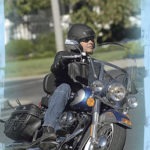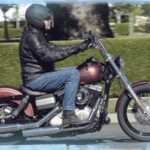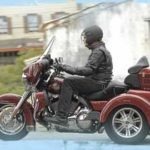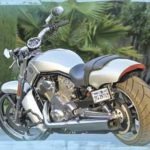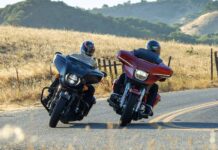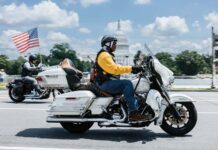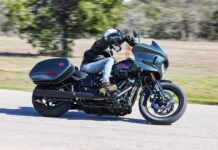Get your lean on
Milwaukee adds Muscle; takes Tourers down to the bone
Sonoma, Calif., July 27–28—Lean times call for lean measures and the 2009 lineup being introduced to the press here in Northern California’s bucolic wine country is a leaned-out stable of 29 mounts—down from 31 last year and 35 in 2007—and some of these models come with markedly leaner sticker prices, which we’ll examine in due course. Lean times also tend to sharpen the corporate focus, prioritizing proven strengths and emerging opportunities in an uncertain market, and for Harley-Davidson that means a heightened attention and three-wheeled addition to the Tourer contingent, the preferred preferred mode of Boomer transport. It also means an expanded emphasis on outreach and on the gratifyingly successful Dark Custom collection that has registered viscerally with a younger clientele.
And that’s enough economic wonkery for now, since ultimately motorcycling is still about having fun, and in keeping with The Motor Company’s recent recession-defying rallying cry of “Screw it, let’s ride,” we’re at Infineon Raceway’s drag strip to flex some Muscles and engage in a little old-fashioned go-to-hell escapism.
There’s a déjà vu quality about the high jinks, recalling how in 2001 the original V-Rod was also introduced to the press at a drag strip, the eighth-mile down in Irwindale, and christened with tire smoke and adrenaline, only this deal’s even better. Andrew Hines and Eddie Krawiec are here to play, just a day after reaching the finals and semifinals, respectively, of the NHRA Pro Stock Motorcycle racing series. And in short order the Screamin’ Eagle boys lesson the swaggering press corps and in so doing prove that the new V-Rod Muscle, with its 1250cc 122 hp Revolution powerplant, is capable of turning the quarter mile in 11.3 seconds at over 117 mph.
I’m not in the same league with these guys. I’m probably not in the same species. It takes me so long to get down the quarter mile that I actually have to pull over midway to take a leak and grab some lunch, but I’m cool with that. It’s better to look fast than to go fast, I say, and on the Muscle I’m a blur at a standstill.
Strictly speaking, the VRSCF V-Rod Muscle is the sole new two-wheeled model from Milwaukee this year, and it’s a radical departure from the VRSC norm. The design directive was, we’re told, to bring additional “rudeness and brutality” to the form, with an emphasis on the “visual mass of the midsection.” The project was designated “Muscle” and referred to the muscle car genre that was the guiding principle of the design. That principle finds immediate realization in the bike’s stylized side-dump side pipes, and in the bold angular sculpting of the enlarged air box, air scoops, radiator shroud and docked rear fender with integrated LED taillight panel. That sculpting was enabled by the use of “sheet molded composite,” a more ductile material than the platform’s signature aluminum, and the same material used to form the body on the Corvette.
That angularity extends to the Muscle’s internally wired handlebars as well as the rearview mirrors, the stems of which serve as striking LED turn signals. A chiseled saddle continues the theme, and does so with some functional advantages, both in operator back support and passenger perch practicality. Repositioned footpegs place the passenger’s feet lower for better comfort, and the operator’s rearward for a more control-neutral posture. A two-piece front fender that accentuates the bike’s brawny torso, an inverted front fork, and a redesigned instrument cluster further distinguish the bike from its stablemates, which for 2009 consist of the returning V-Rod and Night Rod Special. The Night Rod is no more, having slipped off in the night.
XL extinction
Over in the Sportster corner of the barn, the most noticeable change for 2009 is a decline in head count, with both the standard XL 883 and the XL 1200R Roadster being mustered out and leaving but five models (down from nine in 2007). Returning are the Lows and Customs—both 883 and 1200—and the XL 1200N Nightster, the Dark Custom exemplar of the breed. That winnowing out appears to stem from the evolving role of the platform in the grand Milwaukee scheme, as more than ever before it’s being viewed as the domain of the distaff, and the numbers are there to support the view. More than half of XL 883L sales are to the women Harley has targeted in their ambitious outreach marketing. Changes to the returning models are modest and include a more form-fitting front fender and new, lighter rear disc wheels on the Customs.
The Street Bob, Darker still
While the Fat Bob’s been grabbing all the Dyna platform headlines this year, including being chosen for exclusive CVO treatment, it’s the Street Bob that gets the most thorough styling attention for 2009. That attention consists of taking it even further to the Dark side, and enhancing its bobber cred at the same time. The additional Darkness comes primarily from a pair of steel-laced black rims replacing the previous chrome rims, and from the removal of the chrome fender strut covers to reveal the raw black struts beneath. The debonair black-and-polished motor of last year’s model has been replaced with a more primal—and thus more thematically correct— treatment pairing solid-black cylinders with matte-silver cases. A chopped rear fender topped with the retro-style limp-sausage taillight that’s become de rigueur on any self-respecting bobber bring the bike appreciably closer to its stylistic objective.
All 2009 Dynas receive a new front fender that, like the new XL fenders, leaves less daylight between rubber and sheet metal, and a new silver-faced speedo with a fuel range readout function on the odometer. Gone from the family this year is the Dyna Wide Glide, which comes as small surprise, as the model appeared in 2008 only as a limited anniversary edition.
Heaping on the Heritage
You might say that the Softail platform opened its big present early this year, when the groundbreaking—and ground revisiting—FLSTSB Cross Bones was introduced midyear as the opening salvo in the Dark Custom campaign. Fittingly, a direct beneficiary of all the retro features brought to the fold by the Cross Bones is the 2009 iteration of the Heritage Softail, Milwaukee’s original retro-styling exercise introduced in 1986, and a perennial crowd-pleaser ever since. From the Cross Bones the Heritage Classic receives half-moon footboards, oval brake pedal pad, and cat-eye-style dash. That’s a whole lot of additional heritage, and the model gets a number of other styling and functional alterations as well, including higher apehangers, a wider passenger pillion and back pad, and a slew of additional studs and conchos on the saddlebags. The result is a thoroughgoing visual makeover of the model, and you can’t help but wonder if perhaps the Heritage Classic is prospecting for Dark Custom status.
Tourer de force
When I referred earlier to the V-Rod Muscle as the only new two-wheeled model “strictly speaking,” it was because in practice, all seven models in the Tourer platform are entirely new motorcycles as well despite their familiar names and alphabets. Virtually the only things they share with their predecessors are the powertrain and iconic Milwaukee bagger look, and beneath that familiar exterior is a clean-sheet redesign of the rolling chassis that brings a new frame, wheels and tires, and exhaust system to the breed in addition to a host of other significant refinements.
Robotically welded throughout, and consisting of two main members bolted together, the new frame is a rock-solid configuration and a rock-steady one as well, boasting redesigned four-point motor mounts to reduce vibration at an idle, and evidencing none whatsoever under power. Coupled with a new lengthened swingarm, the chassis has a wheelbase a half-inch longer than its predecessor, and that additional stretch provides for more passenger legroom between the footboards and saddlebags. The swingarm has also been beefed up and widened to accommodate a 180mm tire for 2009, and the tire being put into service is described as “dual compound”—it uses a high-mileage compound in the center of the tread and softer stuff out on the edges for stickier cornering. Up front a 17-inch wheel takes the place of the venerable 16-incher. The support brackets for both the saddlebags and Tour-Pak have been beefed up to permit greater payloads while eliminating the tubular loop on the rear fender that previously held the license plate bracket, and the suspension’s been retuned for more compliant handling. There are a number of other refinements, including things like shorter whip antennae, reengineered rear drive compensator, revised pulley ratio, and—I couldn’t help but notice—a sidestand that deploys and retracts with uncharacteristic sureness. But the most significant improvement of all is the exhaust system. No longer do the pipes cross over at the rear cylinder manifold where, as we all know, they did a bang-up job of building up and radiating massive amounts of heat right under the operator and passenger legs. The crossover is now located down at the lower frame rail, away from the riders, and what’s more, the rear header now curves forward of the transmission, further isolating heat from the passenger’s leg. In appearance it’s a drastic break with H-D bagger tradition, but looks real sweet nonetheless and produces a rattlingly resonant exhaust note.
Also in the interest of heat abatement, the Tourer motors have an operator-activated “parade duty” feature that under extreme temperature conditions cuts out the rear cylinder ignition cycle at a standing idle, letting the front cylinder lope along lazily while the rear refreshes itself with gulps of pure atmosphere. A blip on the throttle restores the rear jug to duty instantaneously.
Aside from the exhaust system, the most visible telltale of the Tourer redesign is the view from the rear. A new fender’s been fitted—which is much fatter, naturally, but shapelier too—and the license plate bracket’s been repositioned down low on the Electra Glide Standard, Road Glide and the Road Kings. The Electra Glide Classic and Ultra Classic sport new wide LED skirt fixtures.
The Tri Glide—at last
After the momentous announcement nearly two years ago that Harley-Davidson had entered into a strategic partnership with Lehman Trikes for the purpose of producing proprietary Bar & Shield-badged trikes to be floored in Harley dealerships, things fell abruptly and curiously quiet on the three-wheeled front. While it was tempting to speculate, as time passed and not a peep was heard, that Harley’s ardor for the project had perhaps cooled, we know now that that was far from the case. The development timeline of the new FLHTCUTG Tri-Glide Ultra Classic, as the new trike is designated, mirrors that of the new Tourer frame, and it’s no coincidence. The linchpin here is the two-member construction of the frame, with the tail section being a bolt-on appendage, and thus one that can also be unbolted to deftly accommodate the addition of a whole modular package of three-wheeled running gear and bodywork—which is a five-hour operation performed by a single tech at Lehman’s plant in Spearfish, South Dakota.
We also know now that Lehman’s contribution to the project in the early going was largely in a consultation capacity, sharing their knowledge of general trike engineering and demographics (and in that regard it’s telling that the project was code-named “Code Boomer” in Spearfish) and that the final design was executed entirely by Harley-Davidson. Incorporated into that design are pretty much all of the proven fixes for the handling strangeness endemic to the genre. These fixes include longer front forks, more reach and rake in the triple trees, and a hydraulic steering damper to quell the headshake that trikes typically exhibit under deceleration and hard cornering. The perceived deficit of sufficient power often experienced when bulking up a stock bike with a trike conversion is addressed by giving the Tri-Glide a 103-inch Twin Cam. The rear tires on this model are 200mm jobs—relatively svelte by contemporary trike standards and thus that much easier to boss around.
The Tri-Glide uses dual disc brakes in back with an integrated hand-actuated parking brake, and there is an optional reverse drive offered that’s operated with two buttons on the left-hand switch module. On top of that, you get all of the amenities that come with the two-wheeled Ultra Classic except the ABS.
Price points
In surveying the MSRP roster for the 2009 models, it becomes apparent that Milwaukee is delivering an economic stimulus package of their own to boost sales, at least on a few models. While there are minor price adjustments both up and down across the lineup, it’s the reductions that raise the eyebrows and the steepest cut can be found on the VRSCAW V-Rod, which sheds nearly $1,700 off its 2008 sticker price. Perhaps the most noteworthy discount for 2009, though, is on the ever-popular and ever-desirable Fat Boy, which drops nearly $1,200. Additionally, the Street Bob’s list is down almost $800, and the Road King, nearly $600. The upshot? There are bargains to be had this year, folks.


